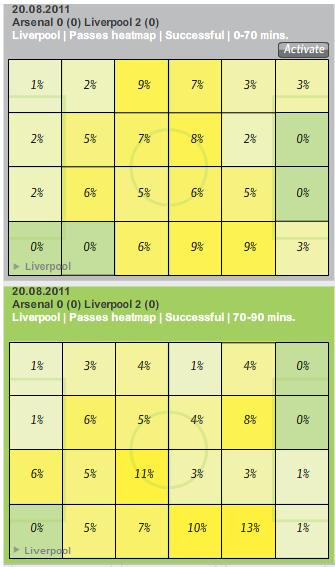Arsenal 0 Liverpool 2 - How important was the sending off?
Liverpool beat Arsenal 2-0 last weekend, and staked an early claim for a place in the top four. But until Emmanuel Frimpong was sent off in the 70th minute, the match was fairly even, with the young Gunner who was making his debut playing well (a few hot-headed moments aside). But what impact did the red card have on the match? The statistics show that Liverpool's passing was markedly more accurate against the ten men; nothing unusual in that, with them having more space to play in and less opposition players trying to stop them, but I took a look at the Guardian's Chalkboards to try to quantify the difference. Here's a comparison of where on the pitch Liverpool attempted their passes before and after the dismissal of Frimpong:

The big difference between the two chalkboards above is that Liverpool actually attempted some passes in the Arsenal box following the sending off, something they'd not managed earlier in the match. It's important to remember that immediately following the sending off Kenny Dalglish made a double substitution: Luis Suárez and Raul Meireles replaced Andy Carroll and Dirk Kuyt. The impact of this can be seen on the chalkboards. The two most attacking wide squares accounted for 7% of the teams attempted passes whilst Carroll was on the pitch. Safe to assume that quite a few of these passes may have been crosses towards the big man. The figure for the same areas dropped to just 2% after his substitution. Liverpool also increased the percentage of their passes in the two squares directly in front of the home team's penalty box; from 7% to 9% after the substitution. This was demonstrated in the central play in the build up to both of the team's goals. Frimpong's self imposed absence lead to space in the middle of the pitch, and Dalglish exploited that superbly with a tactical and personnel switch. I have also taken a look at where on the pitch the completed passes originated from:

As you would expect, these figures mirror the changes seen with the attempted passes - less out wide and more through the middle. Perhaps the key thing here is the 1% figure in the right half of Arsenal's penalty box on the second chalkboard, as this is Meireles' assist for the second goal which wrapped up the three points. Liverpool's passing accuracy stats are the best way to sum up the difference the sending off had on the outcome of the match:
Up to 70 minutes – 377 passes attempted, 281 completed –
74.54%
70 mins to end – 168 passes attempted, 144 completed –
85.71%
Quite a difference. In 22% of the match (the final 20 minutes), the Reds attempted 31% of their total passes, and logged 34% of their total completed passes. Sending off + double substitution = massive difference to result. Kudos to Kenny for making Frimpong's foolishness benefit his team. Please take a look at my other articles, a list of which can be found here.
